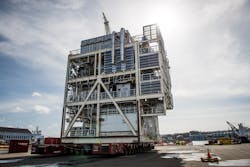Equinor expected production from Phase 1 of its Johan Sverdrup project in the Norwegian North Sea to reach a peak of 470,000 b/d this month, ahead of schedule. Arne Sigve Nylund, EVP for Development and Production Norway, credited higher plant capacity, adding that output had been stable since start-up last October with the 10 wells drilled performing above expectations. Sverdrup’s low operating costs mean that the field continues to provide stable revenue and cashflow both to the partners and Norwegian society as a whole, he stressed. Work continues on Phase 2, which will raise production to 690,000 b/d via a second drilling and production platform connected to the existing field center, with targeted operating costs of less than $2/bbl.
Rosenberg Worley in Stavanger has completed construction of a new 740-metric ton (816-ton) topsides module for processing hydrocarbons from Wintershall Dea’s Nova field in the North Sea. The structure was due to be transferred to Heerema Marine Contractor’s crane vessel Sleipnir for installation on the Neptune Energy-operated Gjøa platform. The module is also designed to supply injection water to Nova from the platform: first gas should follow in 2021.
North Sea operators applying brakes to exploration
Exploratory drilling could be one of the chief casualties of budget cuts in the North Sea area this year, despite strong results from several wells completed during 1Q. Following notifications of postponements, the Norwegian Petroleum Directorate downgraded its estimate of exploration wells across the Norwegian sector from 50 to 40, and could not rule out further reductions in the future. Some planned geophysical surveys have also been delayed or canceled offshore Norway.
While UK offshore exploration recovered in 2019, operators had indicated activity would fall back again in 2020, according to Rystad Energy. Ithaca Energy reacted swiftly to the latest oil price collapse by deferring a planned well on the Fotla prospect, and Rystad expected other UK operators to take similar action. However, most of this year’s scheduled wells already had contracted rigs, so the impact of deferrals will likely be felt more in 2021.
Just as the extent of the downturn was becoming apparent, Total announced a potentially commercial HP/HT gas, condensate and light oil discovery in the Isabella prospect in the UK central North Sea, 40 km (25 mi) south of the company’s Elgin-Franklin production complex. The well, drilled by the jackup Noble Sam Hartley, delivered 64 m (219 ft) of net pay in Upper Jurassic and Triassic reservoirs. Wood Mackenzie analyst Glenn Morrall said the proximity to offshore infrastructure could enhance the field’s economics when market optimism eventually returns.
In the central Norwegian North Sea, MOL found light oil and gas in the Evra/Iving structure, 8 km (5 mi) northwest of Vår Energi’s Balder X redevelopment (the Balder and Ringhorne fields), with potentially up to 71 MMboe recoverable. And Wintershall Dea’s Bergknapp oil discovery in the Norwegian Sea, close to the company’s producing but declining Maria field, could hold up to 97 MMboe.
No change to license round plans
Norway’s Ministry of Petroleum and Energy is pushing ahead with its Awards in Predefined Areas (APA) 2020 licensing round. It plans to include 36 new offshore blocks along with re-offered blocks, although the proposal is out for public consultation. Minister Tina Bru said that despite the present challenges, the industry needed continued stable access to new acreage for petroleum exploration, while the government wants to maintain activity levels on the Norwegian shelf.
Britain’s Oil and Gas Authority too affirmed its commitment to this summer’s planned 32nd UK offshore licensing round, adding that it would be flexible in considering amendments to existing license timelines.
Aker BP commits to Valhall platform clear-out
Aker BP has responded to the recent shocks, like many others, by drawing up various cost-cutting measures, including putting on hold the non-sanctioned redevelopment of the Hod field in the southern Norwegian North Sea. But the company remains committed to a series of platform removals from the Valhall complex that receives Hod’s production.
Last June, Allseas’ Pioneering Spirit removed the 3,800-t topsides from the QP platform, one of the three original facilities at Valhall that will go as part of the modernization of the field center. During 2021-26 the vessel will lift and dispose of the drilling and production/compression platforms and connecting bridges’ and Hod’s 4,600-t unmanned production platform, the first of its type in the Norwegian North Sea. Others to be optionally removed are Valhall’s quarters platform jacket and the 2/4-G jacket on the Ekofisk field, 24 km (15 mi) to the north. •
About the Author
Jeremy Beckman
Editor, Europe
Jeremy Beckman has been Editor Europe, Offshore since 1992. Prior to joining Offshore he was a freelance journalist for eight years, working for a variety of electronics, computing and scientific journals in the UK. He regularly writes news columns on trends and events both in the NW Europe offshore region and globally. He also writes features on developments and technology in exploration and production.

